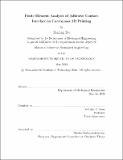| dc.contributor.advisor | Nicholas X. Fang. | en_US |
| dc.contributor.author | Du, Huifeng. | en_US |
| dc.contributor.other | Massachusetts Institute of Technology. Department of Mechanical Engineering. | en_US |
| dc.date.accessioned | 2020-09-03T17:50:15Z | |
| dc.date.available | 2020-09-03T17:50:15Z | |
| dc.date.copyright | 2020 | en_US |
| dc.date.issued | 2020 | en_US |
| dc.identifier.uri | https://hdl.handle.net/1721.1/127164 | |
| dc.description | Thesis: S.M., Massachusetts Institute of Technology, Department of Mechanical Engineering, May, 2020 | en_US |
| dc.description | Cataloged from the official PDF of thesis. | en_US |
| dc.description | Includes bibliographical references (pages 65-68). | en_US |
| dc.description.abstract | Projection Micro-Stereolithography (P[mu]SLA) is one of the most high-throughput additive manufacturing methods, yet preserving the high-resolution characteristic of light-based polymerization techniques. However, further improvement of fabrication speed and precision is usually hindered by the undesired adhesive forces at the curing interface, which is an inevitable consequence of in situ liquid-to-solid phase transition. To overcome this limitation, a bio-inspired super low adhesive interface has been proposed based on the observation of a slippery water layer on the peristome surface of pitcher plant. This hydrophobic layer provides an effective shield to solid adhesion due to its low adhesive energy, and attracting force between fabricated part and UV curing interface is significantly reduced. The introduction of this new lubrication layer not only remarkably improves the fabrication speed, but also increases the refilling rate of liquid pre-polymer resin. | en_US |
| dc.description.abstract | This ultra-low adhesive interface shows promises for pushing the boundaries of continuous 3D printing into a realm of high-throughput additive manufacturing methods ready for industrial applications. In this thesis, I sought to provide a more comprehensive understanding of the solid-solid interaction at the curing interface of 3D photo-polymerizing systems. The state-of- the-art review of current literature suggested that a surface-based cohesive contact theory from a continuum mechanics perspective was the most appropriate model to establish a connection between interfacial material properties and macroscopic measurement results from experiment. Based on that I analyzed the entire mechanical separation process using finite-element method, and provided a semi-quantitative explanation of the stability of such lubricant-infused nano-cavities against peeling forces. | en_US |
| dc.description.abstract | This research lays the ground for elucidating the physical mechanism behind the general adhesion-separation problem, and framework has been constructed in a more general form to allow for analyzing a wide range of interdisciplinary problems involving the dynamics of anisotropic moving contact lines and the propagation of surface instabilities induced by adhesive contact. | en_US |
| dc.description.statementofresponsibility | by Huifeng Du. | en_US |
| dc.format.extent | 68 pages | en_US |
| dc.language.iso | eng | en_US |
| dc.publisher | Massachusetts Institute of Technology | en_US |
| dc.rights | MIT theses may be protected by copyright. Please reuse MIT thesis content according to the MIT Libraries Permissions Policy, which is available through the URL provided. | en_US |
| dc.rights.uri | http://dspace.mit.edu/handle/1721.1/7582 | en_US |
| dc.subject | Mechanical Engineering. | en_US |
| dc.title | Finite element analysis of adhesive contact interface in continuous 3D printing | en_US |
| dc.type | Thesis | en_US |
| dc.description.degree | S.M. | en_US |
| dc.contributor.department | Massachusetts Institute of Technology. Department of Mechanical Engineering | en_US |
| dc.identifier.oclc | 1191844438 | en_US |
| dc.description.collection | S.M. Massachusetts Institute of Technology, Department of Mechanical Engineering | en_US |
| dspace.imported | 2020-09-03T17:50:15Z | en_US |
| mit.thesis.degree | Master | en_US |
| mit.thesis.department | MechE | en_US |
